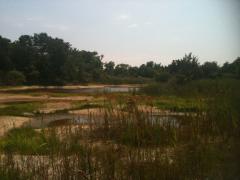Vernal Pools
In the northeastern United States, vernal pools are home to over 500 species. Changing climatic conditions are jeopardizing these important ecosystems as increasing temperatures and delayed rainfall alter hydroperiod and rising sea‐level threatens complete inundation.
Vernal pools are isolated, ephemeral wetlands characterized by a seasonal hydrology that holds water during the winter and spring, dries during the summer, and refills in the fall. Hydroperiod is determined by evaporation, water vapor transport, and precipitation and physical attributes such as proximity to other wetlands, size, surrounding vegetation, and access to groundwater. All of these factors are influenced by local weather conditions. As climate patterns shift, changes in precipitation and temperature will alter hydroperiods of vernal pools causing reproductive failure as amphibian larvae are unable to metamorphose before the pools dries. More severe changes may cause a complete loss of habitat if the pool completely dries or loses its seasonal timing.
 Zoom+ Newly excavated vernal pools in Cape May, NJ (c) Dave Golden
Zoom+ Newly excavated vernal pools in Cape May, NJ (c) Dave Golden
In New Jersey, these pools are critical habitat for amphibians, reptiles, invertebrates, migratory waterfowl, raptors, and songbirds. All 18 of New Jersey's frog species use vernal pools to breed and 2 endangered salamander species breed exclusively in vernal pools, including Cape May's eastern tiger salamander.
Using rare species data and EPA models of climate change-induced sea-level rise we have identified key eastern tiger salamander breeding sites above this anticipated flood level. These sites were targeted for enhancement and new pools were created in 2011 and 2014 to link populations. Since their construction, some of these pools have been successfully colonized by eastern tiger salamanders. By creating metapopulations, we hope to assist the migration of these communities upland off the Cape May peninsula.
By expanding and restoring vernal‐pool habitat on protected land in Cape May County, we are creating sustainable vernal pool complexes that are adapted for changing weather patterns and ensuring that the communities of amphibians, migratory birds, reptiles, and invertebrates that depend on these habitats will persist. This project was the first on-the-ground implementation of adaptive management for climate change in New Jersey and will be used to inform future projects.
Find Related Info: Vernal Pools, Amphibians







